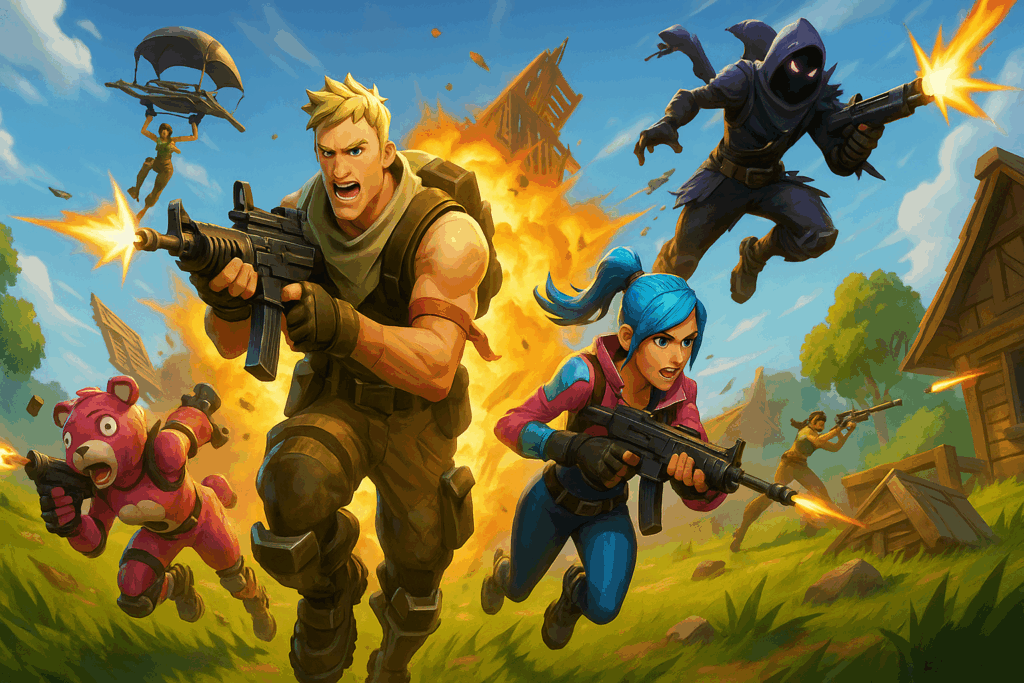Fortnite, the free-to-play battle royale game developed by Epic Games, has transformed from its 2017 debut into a global cultural phenomenon. As of 2025, it boasts over 650 million registered users and generates approximately $5.3 billion in annual revenue, primarily through in-game purchases and collaborations with major brands. This article delves into the latest Fortnite statistics and trends, including player demographics, engagement metrics, revenue streams, esports achievements, and its pervasive influence on pop culture.
Key Fortnite Stats (2025) – At a Glance:
- Total Registered Players: ~650 million worldwide. Fortnite’s player base has grown exponentially since 2017, making it one of the most-played games ever.
- Active Player Count: ~80 million monthly active players on average, with over 60 million daily active players in 2023. Peak concurrent player counts during special events have reached 15.3 million in-game at once.
- Player Demographics: The vast majority of Fortnite gamers are young and male – about 85% are aged 18–35, and roughly 89.7% are male vs 10.3% female (survey data).
- Annual Revenue: Fortnite generates over $5 billion per year in revenue. It earned $5.6B in 2018, and after a slight dip in 2019, revenues climbed back to $5.8B in 2024. In its first two years alone (2018–2019), Fortnite brought in over $9 billion.
- Esports Prizes: Fortnite’s competitive scene debuted with record-breaking prizes – the 2019 Fortnite World Cup featured a $30 million prize pool, including a single $3 million award to the solo champion. Today, annual Fortnite Champion Series (FNCS) events still offer multi-million dollar prize pools (about $7.6M total in 2024).
- Cultural Reach: Fortnite transcends gaming – its in-game live events (concerts, story events) have drawn tens of millions of participants and viewers. A Travis Scott concert in 2020 saw 12.3 million concurrent players in Fortnite, and fans watched over 738 million hours of Fortnite on streaming platforms in 2022. Fortnite’s dances and crossovers with Marvel, Star Wars, and more have cemented its status as a pop culture phenomenon.
In the sections below, we delve deeper into these numbers and what they mean for gamers, media researchers, and digital marketers looking to understand Fortnite’s enduring impact.
Contents
How Many People Play Fortnite in 2025?
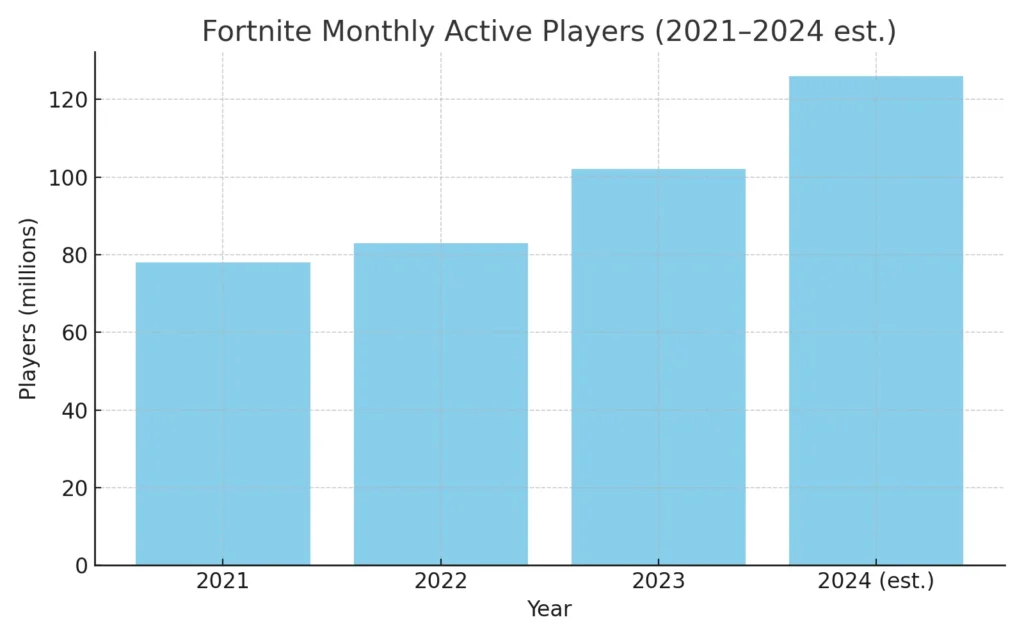
Fortnite’s player base is massive and still growing. Since its launch, Fortnite has attracted hundreds of millions of players worldwide. By the end of 2017, just months after release, Fortnite had about 30 million registered players, and that figure skyrocketed to 200 million by late 2018. Fast-forward to today: as of 2025, Fortnite has approximately 650 million registered players in total. This means nearly half a billion people have tried Fortnite, a testament to its global reach.
More importantly for engagement, Fortnite maintains a huge active player base. The game sees roughly 80–85 million monthly active players on a consistent basis. In fact, 2021 marked a high point with about 83 million MAUs, and 2023 saw monthly actives surge over the 100 million mark (estimated around 126 million at one point). On any given day, over 60 million people play Fortnite worldwide. These numbers indicate an extraordinarily high daily engagement – a reach comparable to a major social network in terms of daily active users.
To put it in perspective, Fortnite regularly sees several million players concurrently online at peak hours, and special events drive those numbers to record highs. For example, a December 2020 Marvel-themed live event (“Galactus”) drew 15.3 million concurrent players – the largest in-game gathering in Fortnite’s history. It’s not unusual for Fortnite to have 3–4 million people playing at the same moment on an average day across all platforms.
Such engagement levels underscore why Fortnite is so important to digital marketers and media observers. The game isn’t just a one-time purchase that players occasionally revisit – it’s a persistent online universe with tens of millions of eyeballs every day. For context, Fortnite’s official website alone draws about 45 million visits per month, hinting at the thriving ecosystem around the game (e.g. checking stats, item shop, etc.). For brands and content creators, Fortnite represents a huge, active audience gathered in one place.
Fortnite Player Demographics by Age and Gender
Who exactly is playing Fortnite? Data shows that Fortnite’s player demographics skew young and male, though there is a diverse mix of ages and a growing female audience. Understanding the makeup of Fortnite’s user base is valuable for game developers, journalists covering gaming trends, and marketers looking to align with Fortnite’s audience.
Fortnite Players by Age
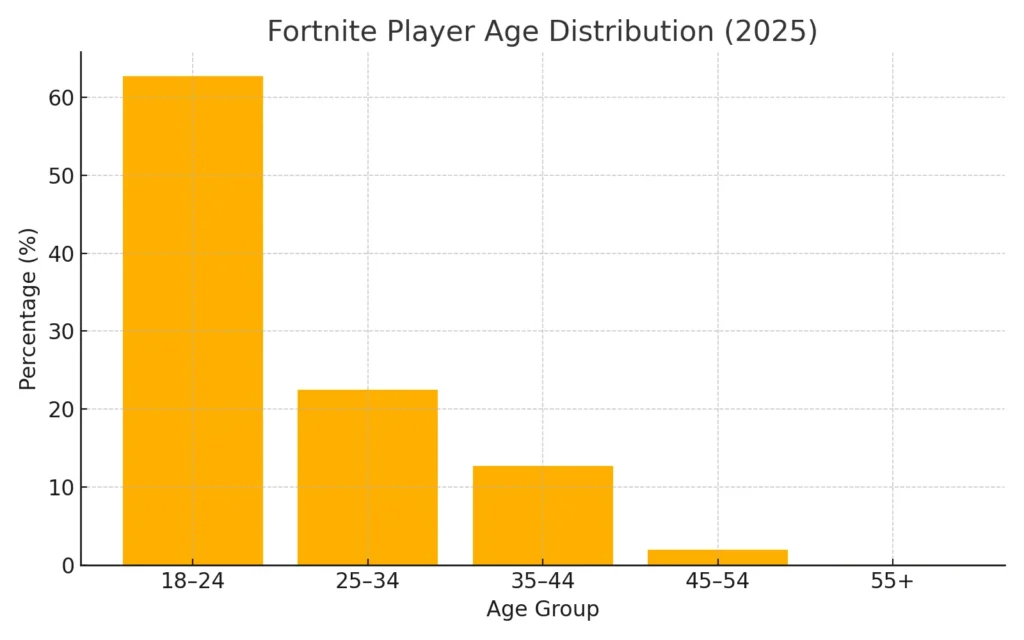
A huge proportion of players are under 25.
Fortnite is primarily enjoyed by younger players in the late teens to mid-twenties range. Surveys indicate over 60% of Fortnite players are between 18 and 24 years old. In one analysis (U.S. data, 2018), 62.7% of players were 18–24. Another 22–25% are in the 25–34 age bracket. In other words, about 85% of Fortnite’s player base is under 35. This aligns with Fortnite’s status as a trendy, youthful phenomenon – many of these players were high school or college-aged during Fortnite’s early explosion in 2018–2019.
Older gamers are less present but not absent: roughly 13% of players are 35–44, and only a small fraction are over 45. Estimates put 2% of players in the 45–54 range, and negligible (0.1%) over 55. It’s worth noting that some younger teens likely misreport their age (claiming to be 18+) to circumvent age restrictions. Fortnite’s appeal to kids and teens is well known – indeed, Epic Games was fined in 2022 for violating children’s online privacy, implying a significant under-13 audience was using Fortnite. But officially, the bulk of the user base falls in the young adult segment.
From a marketing perspective, these demographics mean Fortnite is an excellent channel to reach Gen Z and younger millennials. This age group is highly engaged with digital entertainment and social trends, which Fortnite encapsulates. The game’s constant stream of fresh content (new seasons, skins, events) is tailored to keep this young audience excited and coming back.
Fortnite Players by Gender
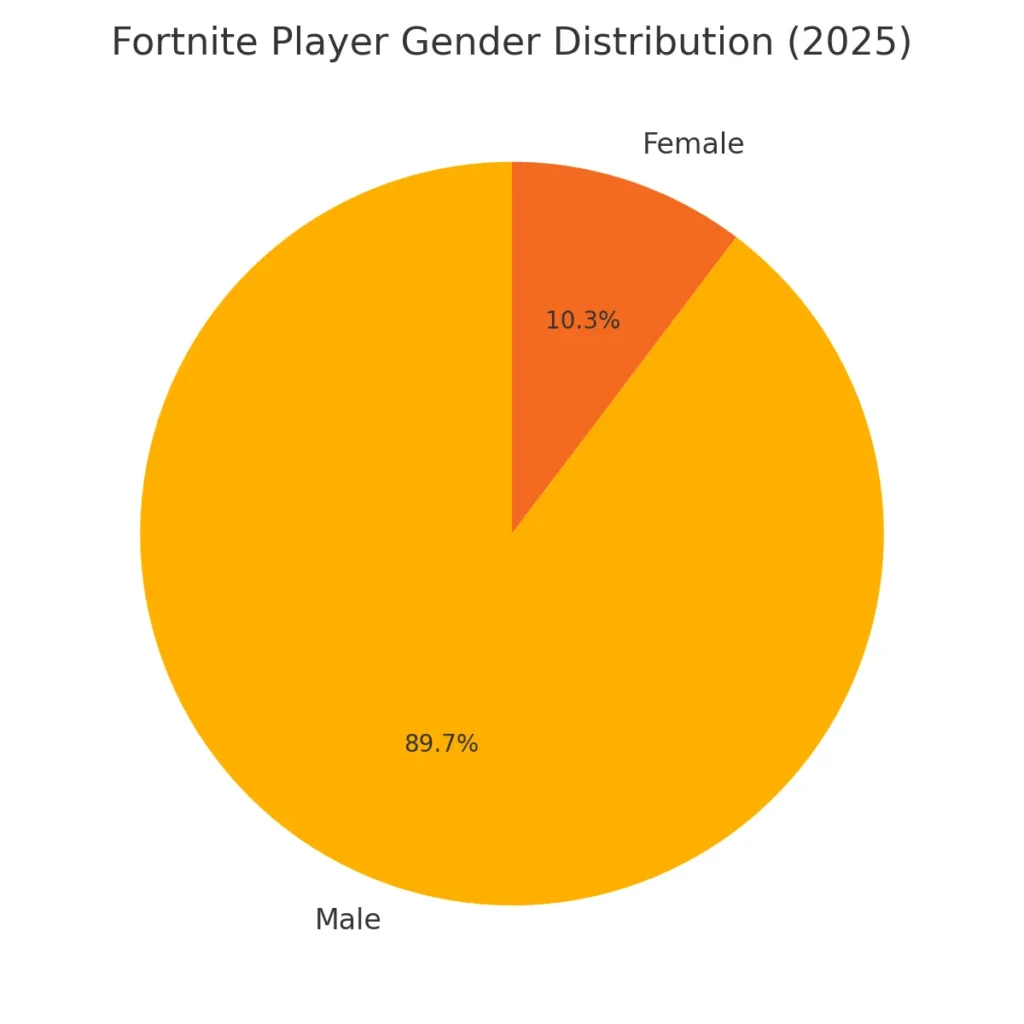
Surveys show Fortnite’s audience is predominantly male, though female participation is significant.
Gaming has historically skewed male, and Fortnite is no exception – but it has made strides in attracting a broader audience. According to a 2022 survey, approximately 89.7% of Fortnite players are male and 10.3% are female. In other words, roughly one in ten Fortnite gamers is female. This male dominance isn’t surprising for a shooter game, but the female player percentage in Fortnite is actually higher than many other competitive titles.
It’s worth mentioning that some surveys have found a somewhat higher female share. For instance, an earlier U.S. study suggested about 27% of Fortnite players were female. The true number may vary by region and methodology, but most analyses agree that Fortnite’s core player community is mostly male. Still, with millions of women and girls playing, Fortnite has one of the largest female player populations in absolute terms, simply due to its enormous scale.
Epic Games has actively tried to make Fortnite appealing regardless of gender – with diverse character skins, dance emotes, and social features that attract a wide variety of players. The cultural impact of Fortnite’s dances and characters has resonated with many female gamers as well. From a media perspective, Fortnite’s near 90/10 gender split highlights both the opportunities (huge male audience) and the challenges (breaking stereotypes to grow female engagement) in gaming marketing. It’s also an important consideration for content creators and esports organizers to ensure inclusivity.
How Much Money Does Fortnite Make?
One of the most astonishing aspects of Fortnite is just how much revenue a free-to-play game can generate. Despite costing nothing to download, Fortnite earns billions through in-game purchases – primarily cosmetic skins, emotes, battle passes, and other downloadable content (DLC). Let’s break down Fortnite’s revenue numbers and trends:
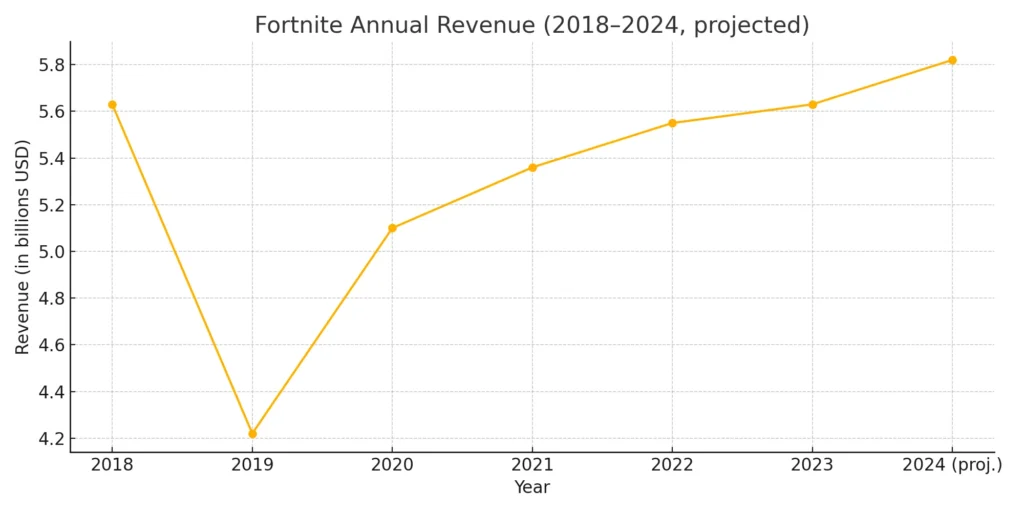
- Total Revenue Milestones: In its first two years after launch, Fortnite reportedly generated over $9 billion in revenue (2018 and 2019 combined). This was an unprecedented start for a F2P game. In 2018 alone – Fortnite’s first full year – it grossed about $5.6 billion, outstripping every other game that year. 2019 saw a slight dip to roughly $4.2 billion (likely due to competition and the Fortnite craze cooling a bit), but that figure still made Fortnite one of the top earners in the industry.
- Annual Revenue Trend: Fortnite’s earnings have remained strong year after year. In 2020, revenue rebounded to an estimated $5.1 billion; 2021 pulled in about $5.36B, 2022 about $5.55B, and 2023 around $5.63B. By 2024, Fortnite was on track to slightly surpass its 2018 record with $5.8 billion in revenueexplodingtopics.com. The growth is expected to continue – projections for 2025 put revenue over $6 billion. (For reference, these figures are often reported as Epic Games’ annual revenue, which primarily comes from Fortnite).
- Average Spending Per Player: A large portion of Fortnite’s player base ends up spending money on the game. A 2020 survey found 77% of Fortnite players had made at least one in-game purchase. The average spend per player was about $85 in 2018, which climbed to $102 by 2020 as the game’s content offerings expanded. Considering a full-priced AAA game costs ~$60, Fortnite’s DLC model has effectively tripled that revenue per paying user over a couple of years, which is a remarkable feat in monetization.
- Revenue Drivers: Fortnite’s income is highly event-driven and content-driven. Major in-game events and new season launches tend to boost monthly revenue by ~23% on average. For example, when Fortnite hosts a big live event or introduces a popular character skin (think Marvel superheroes or Star Wars crossovers), players rush to spend on battle passes and cosmetics, spiking the revenue for that period. This cyclical surge pattern shows how Epic’s strategy of constant updates directly translates into cash flow.
To answer the question “How much money does Fortnite make?” in simple terms: Fortnite has been making about $5+ billion per year, and cumulatively well over $20 billion in its lifetime. Few entertainment properties in any medium have achieved this level of financial success in such a short time.
Revenue by Platform: Fortnite is a cross-platform game (available on console, PC, and mobile), but not all platforms contribute equally to its revenue. Interestingly, console players drive the majority of Fortnite’s spending. Between March 2018 and July 2020, 46.8% of Fortnite’s revenue came from PlayStation 4 users, with Xbox One players contributing about 27.5%. The remaining ~25% was split among Nintendo Switch, PC, and mobile platforms. This dominance of console spending underscores that console gamers, who often prefer playing with a gamepad on TV, form Fortnite’s most lucrative segment – likely because they are accustomed to buying console game content. Mobile Fortnite (before iOS removal) and PC, while having large player counts, didn’t monetize as heavily per user in that period.
From a marketing standpoint, these revenue insights highlight Fortnite’s incredible monetization power. Brands have taken notice – whether it’s Marvel partnering with Fortnite for in-game promotions or musicians doing virtual concerts that sell in-game merchandise, Fortnite has become a platform where entertainment and retail converge. The game’s economy also shows the viability of free-to-play models: keep players engaged with fresh content, and a subset will eagerly pay for optional items, generating billions in profit.
Fortnite Annual Revenue (Epic Games)
| Year | Estimated Revenue (USD) |
|---|---|
| 2018 | $5.63 billion |
| 2019 | $4.22 billion |
| 2020 | $5.10 billion |
| 2021 | $5.36 billion |
| 2022 | $5.55 billion |
| 2023 | $5.63 billion |
| 2024 | $5.82 billion (proj.) |
Top Fortnite Esports Tournaments and Earnings
Fortnite isn’t just a casual game – it also made a splash in the competitive gaming (esports) scene. Epic Games turned heads in 2018 by announcing a whopping $100 million commitment to Fortnite esports prize pools for 2018-2019, an unprecedented figure at the time. This fueled a series of tournaments around the world, culminating in the Fortnite World Cup 2019, which remains one of the most legendary esports events to date.
Fortnite World Cup (2019): The inaugural Fortnite World Cup Finals were held in New York City in July 2019, and they featured a $30 million prize pool spread across solo and duo competitions. This event set records for esports payouts – the solo World Champion, a 16-year-old player known as “Bugha,” won $3 million for first place, which was the largest individual prize in esports history at that time. Over three days of World Cup events (which also included creative mode competitions and celebrity pro-ams), Fortnite awarded a total of $36 million in prizes. The World Cup drew huge viewership online and even filled a 23,000-seat stadium with fans, underlining Fortnite’s potential as a spectator sport.
Bugha’s victory (and others like the duo champions Aqua and Nyhrox) instantly turned top Fortnite players into millionaires and mainstream news stories. This was a marketing win for Epic as well – the headlines about teenagers winning millions at a Fortnite tournament garnered massive media attention, further cementing Fortnite’s cultural impact.
Fortnite Champion Series (FNCS): After the 2019 World Cup, Fortnite shifted to a seasonal format for esports. The Fortnite Champion Series (FNCS) became the primary competitive circuit, with online regional tournaments each Fortnite season, and periodic global championships. While no single event has matched the World Cup’s prize pool, FNCS competitions still offer significant payouts:
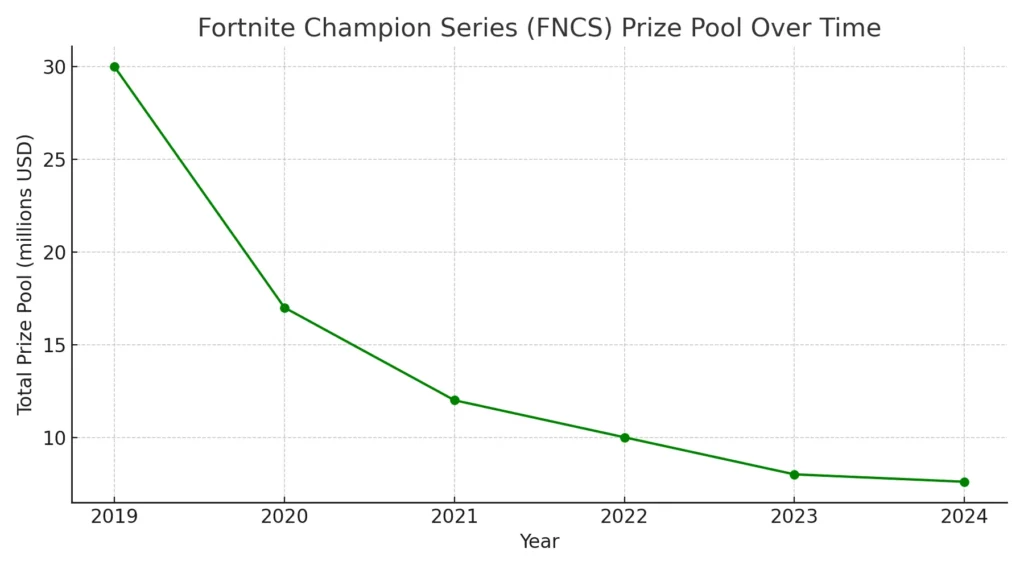
- Recent FNCS Global Championship 2023 (held in Copenhagen) had about a $4 million prize pool for the finals. Teams of two (duos) competed from around the world, with the top duo taking a substantial share of that prize.
- For 2024, Epic announced the FNCS would include three majors and a Global Championship, with a combined prize pool of $7.6 million for the year. The FNCS 2024 Finals (held in Copenhagen again) featured a $2 million prize pool for that single event, slightly lower than 2023’s, but the distribution across multiple majors means opportunities for more players to earn money.
- Typically, each FNCS season awards winning players in the hundreds of thousands of dollars range. For example, an FNCS champion team might win $100k–$300k depending on the event tier, which while smaller than World Cup, still makes Fortnite a lucrative esport for those at the top.
Other Notable Tournaments: Beyond the official FNCS, Fortnite has seen third-party tournaments (like those by DreamHack or Twitch Rivals) and specialty events. However, Epic’s own events dominate the prize leaderboards. There was no Fortnite World Cup in 2020 or 2021 (due to the pandemic and perhaps Epic refocusing), so the competitive scene has been sustained by FNCS. There are rumors and hopes of a future World Cup return, but nothing concrete as of 2025.
In terms of esports earnings, Fortnite has paid out enormous sums in a short time. By some estimates, Fortnite distributed over $150 million in prizes from 2018 through 2022 across all tournaments. The top Fortnite esports earners (players like Bugha, Aqua, JannisZ, and others) have each earned $1–3 million+ in prize money over various events. While newer games like Valorant or League of Legends have structured leagues with salaries, Fortnite’s open tournament format gave young upstarts a chance at life-changing winnings overnight – which was a huge story in competitive gaming.
From a media and marketing angle, Fortnite’s esports chapter showed how a game can double as a spectator sport and advertising vehicle. The World Cup was streamed to millions; it introduced Fortnite to audiences who might not even play games. Sponsors and brands took interest, though Epic itself mostly footed the prize bills rather than rely on external sponsors (as part of their marketing investment). Even though Fortnite esports isn’t as dominant in 2025 as it was around 2019, it still commands a solid following and continues to produce highlight moments that resonate with the gaming community.
Fortnite’s Cultural Impact and Brand Collaborations
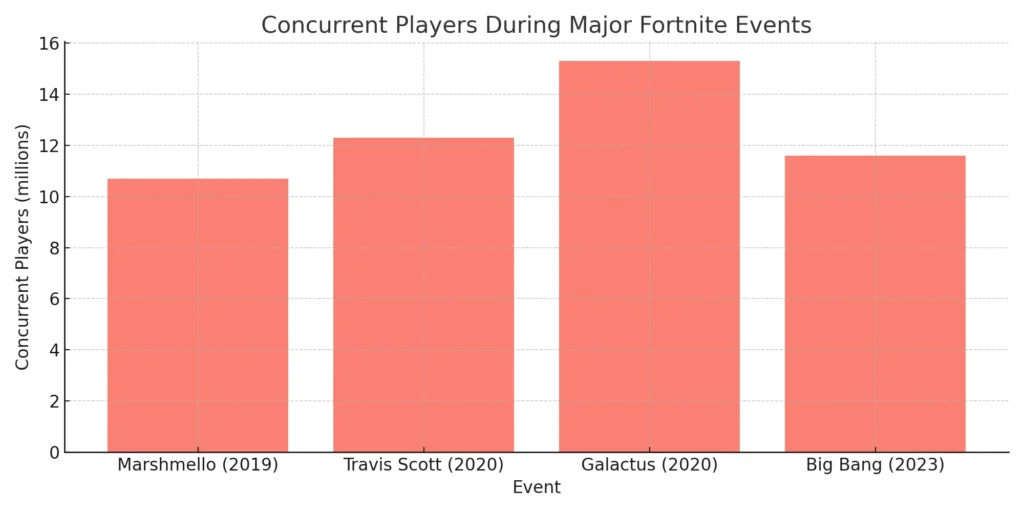
Perhaps the most unique aspect of Fortnite is how it became a cultural phenomenon beyond just a video game. Fortnite’s influence can be seen in music, movies, fashion, and social media trends. This crossover appeal is largely due to Epic Games’ savvy marketing and collaboration strategy, as well as the social nature of the game itself.
- Iconic Dances and Memes: Fortnite popularized a slew of dance emotes (celebratory animations players can do in-game) that went viral in real life. Moves like “The Floss” and “Take the L” originated or were popularized in Fortnite and then were imitated by kids, celebrities, and athletes globally. It wasn’t uncommon in 2018-2019 to see professional athletes do Fortnite dances during real sports events. These dances became an internet meme, further propelling Fortnite’s name in mainstream culture.
- Celebrity Crossovers: Fortnite has hosted virtual events with famous artists and IPs that blurred the line between gaming and entertainment. In February 2019, Fortnite held a live in-game concert with EDM DJ Marshmello, which drew about 10.7 million concurrent players, setting a record at the time. Fortnite topped that in April 2020 with an even more spectacular event starring rapper Travis Scott, which saw 12.3 million concurrent players participating in a surreal, psychedelic concert experience. Over a few days of Travis Scott “tour” performances, 27.7 million unique players took part (many attending multiple shows) – numbers on par with a major global sporting event audience! These concerts generated massive buzz on social media and showed the potential of games as virtual concert venues. Epic reported that Travis Scott’s event was an all-time high concurrency and an “all-time record” for Fortnite, until it was eclipsed later that year by the Marvel’s Galactus event with 15.3M concurrents.
- Franchise Collaborations: Fortnite’s myriad crossover promotions with big franchises have kept it constantly in the pop culture spotlight. Epic has teamed up with Marvel, DC Comics, Star Wars, NFL, NBA, Dragon Ball Z, Naruto, and many more to bring famous characters into Fortnite. Players can buy and play as Spider-Man, Darth Vader, LeBron James, or even Goku – an unheard-of mashup of universes. These collaborations benefit both sides: Fortnite gets fresh content that lures fans, and the brands get exposure to millions of players. One media site noted that “Fortnite has had numerous collaborations with pop culture franchises, including Marvel, DC, and music legends like Eminem”. It’s become a marketing platform where major studios and companies eagerly participate. For example, when Marvel releases a blockbuster movie, you might see tie-in Fortnite skins or game modes, effectively turning Fortnite into an interactive advertisement (that players gladly pay for!).
- Metaverse and Social Hub: Fortnite’s evolving Creative mode (and the newer Unreal Editor for Fortnite) allows players and creators to build their own experiences, which has attracted brands to create sponsored content. For instance, there have been Fortnite creative maps for promotions like a Star Wars: Rise of Skywalker preview clip and even a Ferrari in-game integration when the car maker added a model for players to drive. Fortnite’s world is often described as a proto-metaverse – a social space where people hang out with friends, attend events, and experience branded content, not just a competitive game. During the pandemic, Fortnite became a virtual gathering place for many.
- Mainstream Recognition: Fortnite’s cultural impact has been recognized widely. It was the subject of numerous mainstream news articles and even academic studies on gaming trends. The game’s influence on fashion (with high-profile streamers and fans sporting Fortnite-themed clothing), music (artists launching songs in-game), and media is substantial. Even years after release, Fortnite remains a trend-setter in the industry – for example, its collaborative events model has been emulated by other games trying to replicate Fortnite’s success in blending entertainment and gameplay.
Fortnite’s cultural relevance is a key reason why it continues to be a focal point for marketers. If you’re targeting youth culture or the gaming community, Fortnite is often “where it’s at.” It offers a shortcut into a massive, engaged audience who are very online and receptive to cool, interactive content. From the perspective of gaming journalists or media researchers, Fortnite’s cross-media experimentation (concerts, movie tie-ins) provides a fascinating case study of how a game can become a platform and a social phenomenon.
Conclusion
Fortnite’s journey from a game mode hastily added in 2017 to a global powerhouse in 2025 is nothing short of remarkable. The numbers speak for themselves: hundreds of millions of players, billions in revenue, record-breaking event participation, and a lasting imprint on popular culture. Fortnite has proven that a video game can be more than just a game – it can be a social network, a concert hall, a marketing channel, and a cultural touchstone all at once.
For gamers, Fortnite remains a dynamic and fun experience that continues to evolve with new content, creative modes, and competitive play. For gaming journalists and media, Fortnite provides an endless well of storylines – from esports prodigies winning millions, to debates over kids’ screen time, to the game’s legal battles and business moves (such as its 2020 clash with Apple over App Store policies). And for digital marketers, Fortnite exemplifies how an interactive platform can captivate a generation: brands that partner with Fortnite can potentially reach tens of millions of eyeballs in a very authentic way.
As of 2025, Fortnite shows no signs of slowing down significantly. Its player base is holding strong, revenue is climbing modestly, and Epic Games continues to double-down on innovation (with things like the Unreal Editor for user-made content, and constant high-profile collaborations). The game that popularized the battle royale genre has outlasted many competitors and has continuously reinvented itself to keep players interested.
In summary, Fortnite has rewritten the rules of engagement in gaming and marketing. It demonstrated the power of free-to-play done right, the importance of community and constant updates, and the huge crossover potential between gaming and other entertainment industries. Whether Fortnite eventually wanes or not, its impact on gaming and digital culture will be felt for years to come. For anyone looking to understand the state of gaming in the mid-2020s, Fortnite’s stats and success story are essential knowledge – a case study of a phenomenon that bridged the gap between game and global cultural icon.
Analysis & Insights: What Fortnite’s Stats Reveal About Gaming in 2025
1. Fortnite Has Mastered the Live-Service Model
With billions in annual revenue and over 650 million players registered, Fortnite remains the benchmark for what a live-service game can achieve. Unlike traditional boxed games, Fortnite thrives on frequent content updates, real-time events, and a robust in-game economy. This model isn’t just sustainable—it’s thriving, especially among Gen Z players who value continuous, interactive experiences.
Takeaway: Fortnite proves that free-to-play + cosmetics + cultural relevance = long-term profitability.
2. Young, Global, and Highly Engaged
Fortnite’s audience is overwhelmingly young (85% under age 35) and global, with top markets in the U.S., Brazil, Russia, and Europe. The game enjoys 60+ million daily active players and incredibly high repeat engagement. Fortnite’s live events draw millions, showing that younger gamers crave shared digital experiences that feel like social events, not just gameplay.
Takeaway: For marketers and brands, Fortnite remains one of the most direct pipelines to Gen Z and younger Millennials worldwide.
3. Esports Was the Flash, Creator Content Is the Fuel
While the 2019 World Cup delivered headline-grabbing prizes, Fortnite’s long-term esports scene has settled into smaller but consistent FNCS seasons. However, creator-led content now drives more daily engagement. With over 70,000 creators monetizing Fortnite maps and experiences in 2024 alone, Fortnite has evolved into a creator economy platform.
Takeaway: Fortnite is no longer just a game—it’s a UGC ecosystem. The next viral moment might come from a 14-year-old’s custom Creative map, not a pro tournament.
4. From Game to Platform to Pop Icon
Fortnite’s influence on culture is unmatched. With crossover events involving Marvel, Travis Scott, Star Wars, Dragon Ball Z, and even Nike and Balenciaga, it functions like a pop culture blender. These events draw millions, turning Fortnite into an event-based platform for brand storytelling and fan engagement.
Takeaway: Fortnite has become a marketing sandbox—where brands, artists, and fans interact in real time.
5. Metaverse Moves Without the Buzzword
Without calling itself a “metaverse,” Fortnite has quietly become the most practical version of one—a persistent, interactive, socially engaging 3D world where players attend concerts, play mini-games, chat, and spend money. The Unreal Editor for Fortnite (UEFN) is accelerating this trend, making it easier for third parties to build full-blown experiences within the game.
Takeaway: Fortnite’s long game is bigger than battle royale. It’s laying the foundation for the future of virtual events, social gaming, and branded experiences.
Final Insight:
If you want to understand the future of gaming, youth culture, virtual marketing, or creator economies—start with Fortnite.

